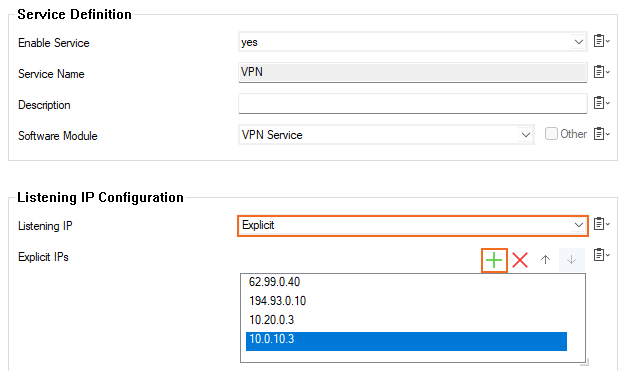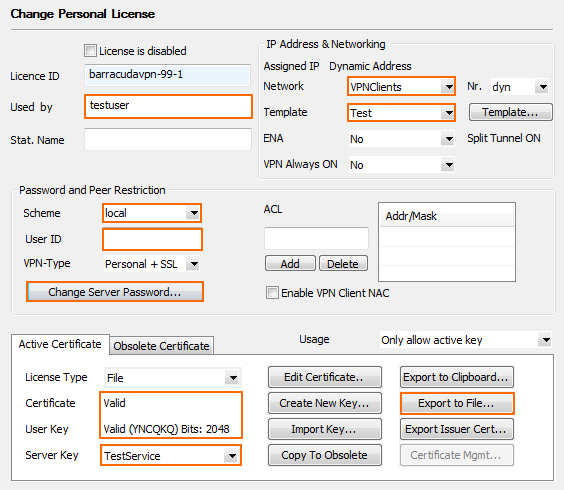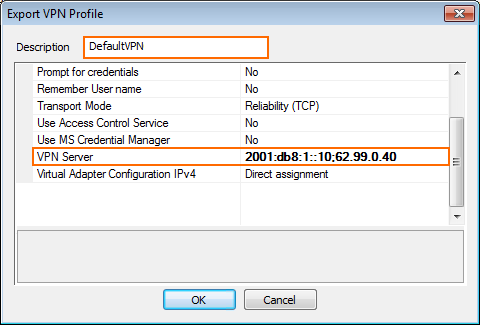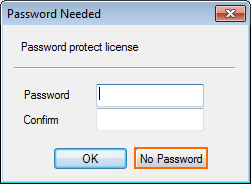To let mobile workers securely connect to corporate resources, you can configure a client-to-site TINA VPN. Follow the steps in this article to configure a client-to-site VPN with the built-in Barracuda CA (lic files). To connect to this type of VPN, clients require the Barracuda VPN Client, an optionally password-protected certificate license file, and a server password. You can connect from any IPv4 or IPv6 address, as long as an external IPv4 and IPv6 address are configured as a service IP address for the VPN Service. Traffic passing through the client-to-site VPN is limited to IPv4. Only one simultaneous connection is possible for personal licenses. Use VPN Group policies and an Advanced Remote Access subscription to be able to have multiple concurrent connections by the same user.

Supported VPN Clients
The following VPN clients are compatible with this client-to-site configuration:
Before You Begin
Set up the VPN certificates using the Barracuda VPN CA. For more information, see How to Set Up Barracuda VPN CA VPN Certificates.
Identify the subnet (static route) or a range in a local network (proxy ARP) to be used for the VPN clients.
Step 1. Configure the VPN Service Listeners
Configure the IPv4 and IPv6 listener addresses for the VPN service.
Go to CONFIGURATION > Configuration Tree > Assigned Services > VPN > Service Properties.
Click Lock.
From the Listening IP list, select the source for the IPv4 listeners of the VPN service.
When selecting Explicit, click + for each IP address and enter the IPv4 addresses in the Explicit IPs list.

When using IPv6:
Click + to add an entry to the Explicit IPv6 IPs.
Select an IPv6 listener from the list of configured explicit IPv6 service IP addresses.
Click Send Changes and Activate.
Step 2. Configure the Service and Default Server Certificates
Go to CONFIGURATION > Configuration Tree > Box > Assigned Services > VPN-Service > VPN Settings.
Click Lock.
Verify that the Default Server Certificate and Default key are both valid (green). If the Default Server Certificate and Private key are not valid, see How to Set Up Barracuda VPN CA VPN Certificates.
In the left menu, select Service Keys.
Right-click the table, and select New Key.
Enter the Key Name.
Select the Key Length.
Click OK.
Click Send Changes and Activate.
Step 3. Configure the VPN Client Network
Go to CONFIGURATION > Configuration Tree > Box > Assigned Services > VPN-Service > VPN Settings.
Click Lock.
In the left menu, select Client Networks.
Right-click the table, and select New Client Network.
In the Client Network window, configure the following settings:
Name – Enter a descriptive name for the network, e.g.:
Client to Site VPN NetworkType – Select the type of network that is used for VPN clients:
routed (Static Route) – A separate subnet. A static route on the Barracuda CloudGen Firewall routes traffic between the VPN client subnet and the local network.
local (proxy ARP) – A subnet of a local network. For example, Local network:
10.0.0.0/24, Local segment10.0.0.128/28. You must also specify the IP range for the network:IP Range Base – Enter the first IP address in the IP range for the VPN client subnet, e.g.:
10.0.0.128.IP Range Mask – Specify the subnet mask of the VPN client subnet, e.g.:
28
Network Address – Enter the default network address, e.g.:
192.168.6.254. All VPN clients will receive an IP address in this network.Gateway – Enter the gateway address, e.g.:
192.168.6.0
Click OK.
Click Send Changes and Activate.
Step 4. Create a Barracuda VPN CA Template
Go to CONFIGURATION > Configuration Tree > Box > Assigned Services > VPN-Service > Client to Site.
Click Lock.
Click the Barracuda VPN CA tab, and then click the Templates tab under it.
Right-click the table, and select New Template.
In the Barracuda Templates window, configure the following settings:
Name – Enter a descriptive name for the template.
(optional) DNS – Enter the IP address and Domain of the DNS server.
(optional) WINS – Enter the IP address of the WINS server.
Network Routes – Add the routes to the local network. Enter the IP address, e.g.:
10.0.0.0/24and click Add to add the entry.Accepted Algorithms – Select the algorithms that the VPN server will offer. Recommended settings:
AES for licensed systems.
DES for export restricted systems.
Click OK to save the template.
Click Send Changes and Activate.
Step 5. Add a Personal License
Go to CONFIGURATION > Configuration Tree > Box > Assigned Services > VPN-Service > Client to Site.
Click Lock.
Click the Barracuda VPN CA tab and then click the Pool Licenses tab under it.
In the upper table, select your VPN Pool Licenses.
Right-click the lower table, and select New personal license.
Select an index number for the new license, and then click OK. The Personal License window opens.
In the Used by field, enter the name of the user. E.g.,
Test UserEnter the IP Address & Networking settings:
Network – Select the VPN client network configured in step 3.
(optional) Template – Select a Barracuda VPN CA Template.
(Windows NAC Client only) ENA – Select to prevent clients from accessing any other than the published VPN network.
Configure the authentication service in the Password and Peer Restriction section:
Select local to use a server password to log in. Click Change Server Password to set a server password.
For external authentication servers, select the scheme, and enter the User ID user name. The user must enter the password associated with this user when logging in. For more information, see Authentication.
Select the VPN Type (default: Personal + SSL) to enable personal VPN client connections and / or connections via CudaLaunch and the SSL VPN web portal.
(Optional) To specify a network ACL, enter all networks that should be reachable by the VPN clients and click Add.
(Windows NAC Client only) If the license requires the Barracuda VPN Client to be installed, set VPN Client NAC to Required or Optional.
Click the Active Certificate tab.
Select the server certificate from the Certificate list. E.g., ServerCertificate.
Verify that the Certificate and User Key are listed as Valid.
Click Export to File and Export to *vpn file. The Export VPN Profile window opens.

Enter a Description.
Enter the public IPv4 or IPv6 address the VPN service is listening on. Separate multiple IP addresses with a semicolon.

Click OK.
(optional) Enter a password to protect the file, and click OK, or click No Password.

Click Send Changes and Activate.
In the Status column next to the new personal license, a green check mark indicates that the license file can now be used on a client to connect to the VPN.

Step 6. Add Access Rules
Add two access rules to connect your client-to-site VPN to your network. For instructions, see How to Configure an Access Rule for a Client-to-Site VPN.
Monitoring VPN Connections
On the VPN > Client-to-Site page, you can monitor VPN connections.

The page lists all available client-to-site VPN tunnels. In the Tunnel column, the color of the square indicates the status of the VPN:
Blue – The client is currently connected.
Green – The VPN tunnel is available, but currently not in use.
Grey – The VPN tunnel is currently disabled. To enable the tunnel, right-click it and select Enable Tunnel.
For more information about the VPN > Client-to-Site page, see VPN Tab.
VPN Log File
The VPN service uses the /VPN/VPN log file.
